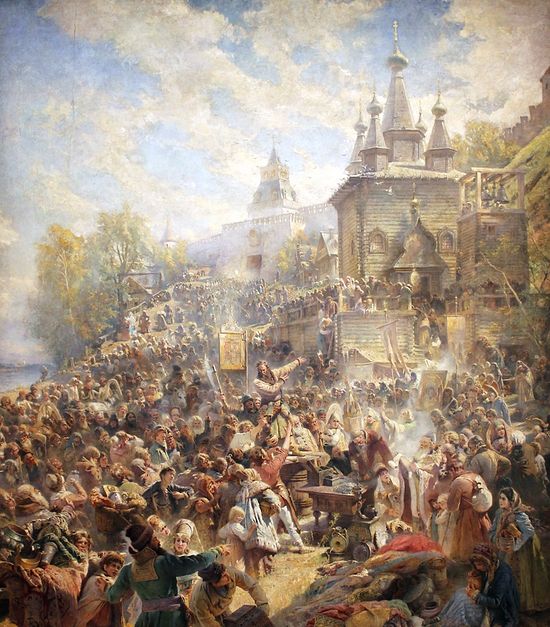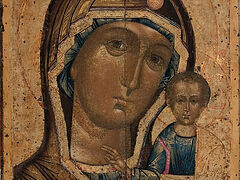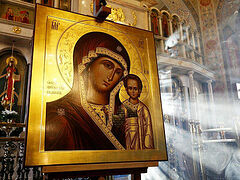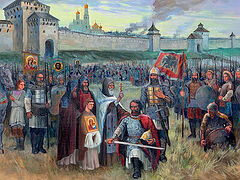 Minin in Nizhny Novgorod square summons people to contribute. Artist: K.E. Makovsky
Minin in Nizhny Novgorod square summons people to contribute. Artist: K.E. Makovsky
In one of my articles, “About St. Sebastian,” I reflected on how our understanding of the meaning of the saints’ accomplishments is handicapped by a lack of relevant historical knowledge. There is another connection here—if the saint was greatly revered by his contemporaries, but later this veneration weakened, it means that we don’t grasp the essential meaning of his accomplishment within its historical context. Why was he so revered? What did his ascetic labors mean to our ancestors? What if in our day, centuries later, our society changed beyond recognition, the labors of this saint can still be paradoxically close to the way we live? Could it be that we have many more reasons to seek his prayerful intercession than meets the superficial eye?
People have always tried to interpret their intimate connection with the saints in their daily life, even if this frequently morphs into a search for connections between, for example, martyrdom by beheading and alleviating headaches... Well, even if this connection isn’t the most important one, it’s a connection nonetheless!
Let’s take, for example, the Holy Righteous Princes Boris and Gleb. Not every church serves a Polyeleos on their commemoration day, while a majority of believers, even if they do begin talking about their exploits, will have nothing more to say than generalities: They did not want to cause strife, they humbled themselves and were killed...
Humility and unwillingness to cause strife… We understand what it means to some extent... Or we seem to know what it’s about. But where is the origin of former pagans’ veneration of these princes? Pagans who knew nothing but the language of coercion, who kidnapped women and had no qualms about selling their fellow tribesmen into slavery to other tribes?
It is true that it would be hard to find anything heroic in the princes’ death—the older brother tried to defend himself, while the younger, still a teenager, just humbly begged his murderers: “Let me be your slave, don’t kill me!”
But their veneration in Rus’ was simply unprecedented—so widespread and deeply reverent it was... The people honored their memory and glorified them even before they did Grand Prince Vladimir!
So, what’s the reason for this response in the hearts of rough, unrefined tribal people, who had neither consciously accepted Christianity nor were spiritually cultured yet?
One modern nationalist, who accuses Boris and Gleb of infantilism and assumes that Christianity preaches weakness, is simply unaware of the power those princes possessed and the realities of life at the time. He does not take into account that not only a prince, but even a prince’s retainer was trained for military service from the age of five. A modern observer can’t fully grasp what a high level of training this implied. As for the prince, he was also groomed to act as a military leader and a ruler. Assuming that even in the early nineteenth century, boys as young as fourteen or sixteen were capable of serving as officers (that is, both as military men and commanders), then what is there to say about austere ancient times?
Infantilism? For Christ’s sake! When did it become possible for the phrase, “a game worthy of real men”, to be used as a computer wargame ad? You are playing with tin soldiers, old man! Should our generation even speak of someone else’s infantilism?!
Sts. Boris’s and Gleb’s contemporaries knew what a prince could do and what he couldn’t. Even in his adolescent years, he could still summon a smaller or greater number of warriors under his banner and begin his struggle for power. If he lost it, he could take his warriors to other lands, go under the authority of some sovereign, or settle down somewhere far away, conquering a local tribe and invading other tribes in pursuit of gain.
According to a proverb of later times—“The pleasures of the mighty are the tears of the poor”—all this would be accomplished through the grief and desolation of simple folk. A prince would spill innocent blood, burn their huts, trample their crops, and the caravans of desperate captives would trail down towards the slave markets of the East.
A prince couldn’t die for the common folk. Boris and Gleb did... This is what stunned their contemporaries
So, a prince simply couldn’t die for the wellbeing of ordinary people. He could give his life for his princely interests, his military dignity and glory—he could easily give three lives for that... As for the peaceful life of villagers and serfs—never!
But Boris and Gleb did... This is what stunned their contemporaries. They poignantly felt that these men had given their young, regal lives for each one of them, the commoners, whose lives were of little worth in the eyes of the world in those days. It was Christ’s most powerful sermon as the King Who was voluntarily raised upon the Cross to save the world—and also the most easily understandable sacrifice that could ever soften the hearts of half-heathen people.
***
The Church calendar includes nationally observed feasts, but people have partially lost the story behind them; or know nothing of the time in which they were most solemnly celebrated. Let’s take, for example, the celebration of the Kazan Icon of the Mother of God. When we read about it, we learn about the many miracles that took place at the time of its finding. But we can hardly understand why the churches are particularly packed with people on the Feast of the Kazan icon of the Mother of God. After all, other icons of the Most Holy Mother of God were also glorified by enumerable accounts of miracles.
Well, all of us have surely heard that the autumn celebration of the Kazan icon was established in remembrance of Russia overcoming the Time of Troubles. A simple semantic analysis would help anyone figure out that there was nothing comforting during that period, and it’s really good that we overcame it. As for the icon, it was kept in the victorious Second Militia camp, inspiring its members to keep on fighting.
But somehow all the fine details went missing...
Those fine details have actually caused those hard-hearted people to seek the intercessions of the Most Holy Mother of God, and melt into tears of gratitude from the living manifestation of Her intercessions.
The Time of Troubles lasted much longer than what we learned from our high school history course. It didn’t last for a year or five years, or even ten
So, here are the fine details: The Time of Troubles lasted much longer than what our sketchy high school history course taught us. Catastrophic climate change, supposedly caused by the eruption of a super volcano in South America, led to crop failure over a period of three years, from 1601 to 1603. Famine caused diseases and riots, exacerbated by the fact that the noble boyars deliberately sought to harm the hated lowborn tsar. In response, the tsar grew savage and ratcheted up repressions...
Before the country had time to recover from the devastation of those years, it entered the major stage of the Time of Troubles that everyone knows the most about: In 1604, the first usurper began his march on Russia. Then followed the second, third, and fourth... Next came the time of the “thieves”. If during the previous years the number of robber bands rose exponentially, this time around, due to the total paralysis in the ruling class, the “thieves” became the masters of the land.
Taking advantage of the degradation of frontier guard services, hordes of Nogais and Crimeans ravaged the country, easily reaching its central regions.
At the same time, the country was ruthlessly plundered by large and small groups of Poles, Lithuanians, Swedes, Germans and Cossacks, who travelled back and forth across the land, driven by both constantly changing political situations and greed.
Impunity produced in these mobs an intoxicating sense of power over other people’s lives—it is terrifying even to read what people are capable of doing to one another.
It is frightening to even read what people are capable of doing to one another
Recalling the horrors of the Great Patriotic War [WW2], we typically say, “It lasted almost four years…” But the Time of Troubles lasted not one, not five, not even ten just years... Moscow was liberated from the Poles only at the end of 1612. But that was just Moscow! The war with the Swedes in the country’s northwest lasted until 1617, while the plundering inroads of large mixed bands of Polish gentry and Cossacks continued until 1618.
However, even knowing the time span of the Time of Troubles doesn’t give us a full grasp of the scale of trials people enduring during that period—to what extent the country was devastated at the time. Those who weren’t killed or taken into captivity, who didn’t flee and managed to survive hunger and disease, were left in such a desperate state that they had to live in dugouts, possessing neither livestock, nor supplies, nor any tools—as the chronicles described, living “like animals.” Many villages lay smoldering in ruins, arable land was overgrown, the churches were looted and desecrated...
There was no one left to bury the dead. In some areas of the country (despite the high birth rate of the time), the population level was restored only half a century after the beginning of the Time of Troubles!
The Russian land hadn’t seen such devastation since the Batu Khan invasion. “Complete devastation”—was what the people felt before the Second Militia—which was guided by a divine call and blessed by the Most Holy Mother of God, bringing hope for deliverance.
The troparion to the icon of Our Lady of Kazan begins: “O fervent Protectress,”—and it was in this intercession against merciless enemies that the mercy of the Mother of God shone forth to the people in the most relatable way. Our nationwide veneration sprang from what was common knowledge to all the people: We were delivered from inevitable ruin.



